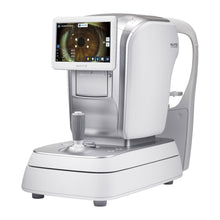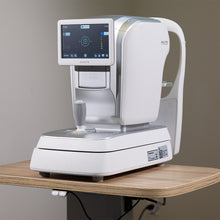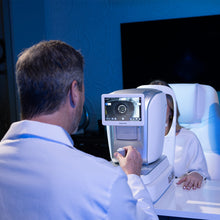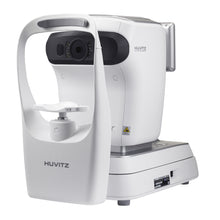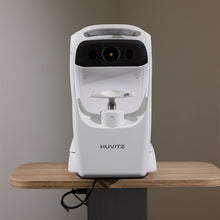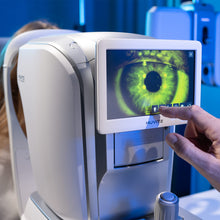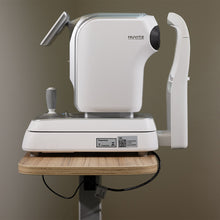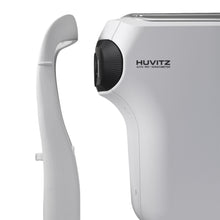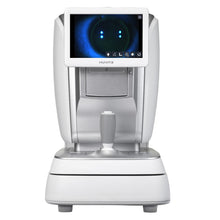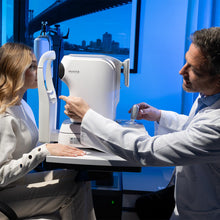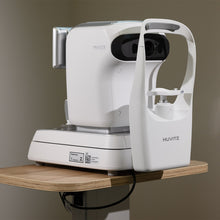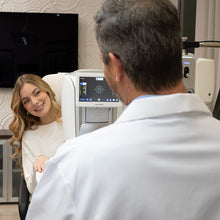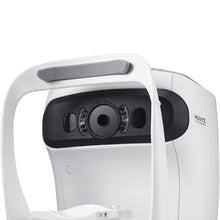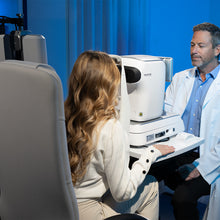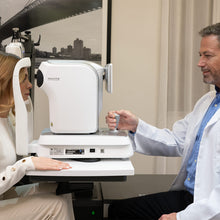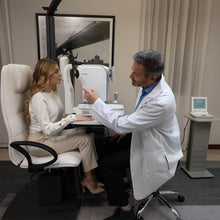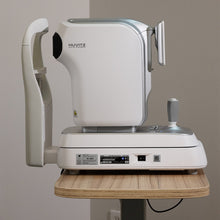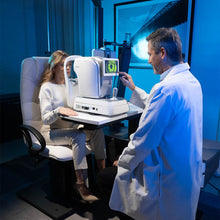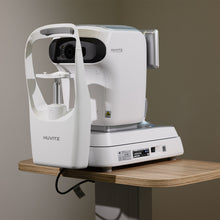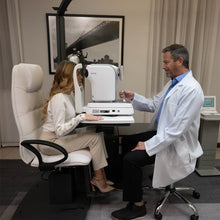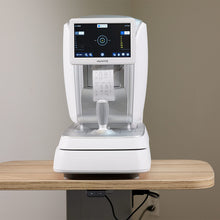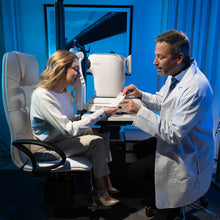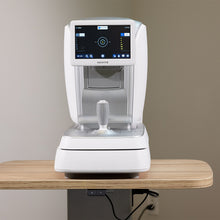Huvitz Autorefractor Keratometer HRK-8100A
Huvitz HRK-8100A Autorefractor Keratometer delivers exceptional precision in diagnostic measurements. Combining the capabilities of an autorefractor, autokeratometer, and wavefront aberrometer into a single high-tech instrument, the HRK-8100A sets itself apart. Utilizing a Hartmann-Shack wavefront sensor, it analyzes multiple focal spots of a light wavefront, not only measuring basic refraction errors but also generating a spatially resolved wavefront map. The HRK-8100A features a unique wavefront analysis algorithm that provides high-order aberration data for customized lenses and facilitates patient observation before and after refractive surgery. Discover the advanced capabilities of the HRK-8100A Auto Refractor/Keratometer.
Precision Vision Correction with HRK-8100A

The micro lens array independently developed by Huvitz comprises hundreds of small lenses that provide numerous data points, allowing for precise diagnosis of refractive errors.
MICRO LENS ARRAY
Huvitz's own developed Micro Lens Array creates multiple distinct focal spots, from which the pattern provides valuable information about the customer's ocular system. This precise measurement and data analysis technology focuses on ocular characteristics.

In addition to conventional data like Spherical, Cylinder, and Axis, high-order aberration data is displayed in a graphical Zernike map, providing a deeper understanding of the patient's eyes and enabling superior clinical decision-making.
Updated High-Order Aberration Mapping
High-order aberration data such as Coma, Trefoil, Spherical Aberration, Secondary Astigmatism, and Tetrafoil, previously only available in wavefront aberrometers, is now accessible with the Huvitz HRK-8100A! This clinical data is now at your disposal.
Before & After Cataract Surgery Tracking Observation
High-order aberration information that cannot be measured by subjective refraction can be obtained. The new auto ref-keratometer can measure high-order spherical aberrations that often occur after surgery.
Customized Lens Manufacturing
The high-order aberration and Zernike map data output function enables premium custom spectacle or contact lens manufacturers to improve vision accuracy and power."

Point Spread Function (PSF) and chart simulation of retinal display significantly enhance patients' understanding of their clinical eye status and the benefits of customized lenses.
Exploring Measurement Modes: Enhancing Precision in Eye Care
It is the mode designed solely for measuring refractive power.


It is the mode designed solely to measure corneal curvature.


This mode continuously measures both corneal curvature and refractive power.



It is the mode to measure the curvature of part around cornea. Based upon the center of cornea, measure the curvature of part around cornea from the positions of up/down and left/right direction. It is to indicate the relative eccentricity while comparing the curvature of part around cornea with the curvature of corneal center. The eccentricity means how even the part around cornea is compared to the corneal center. Generally, human cornea has the highest curvature and the longer the distance from the corneal center is it gets more even. Consequently, in case of prescribing lens such as RGP with corneal center curvature only, the patient can feel uncomfortable while putting on the lens. It is possible to select the appropriate lens considering the characteristics of patient by using the eccentricity of part around cornea calculated in KER-P mode.

Our product, the HRK-8100A, utilizes a separate measurement method for intraocular lens or cataract assessments. It is designed to observe the condition of eye health, including in patients with lenticular opacity from cataracts or corneal injuries caused by wearing contact lenses.

The auto ref-keratometer features a Full Color CCD camera and a white LED light source, allowing you to assess the contact lens fitting status—a capability previously available only with slit lamps.
It is used to observe the patient's eye using white LED lighting in a color image.

It is used to observe the fit of contact lenses on the patient's eye using a blue LED and a fluorescent solution.

This function allows the operator to see the fit of the contact lens more clearly and accurately.


The world's first contact lens fitting function in an Auto Ref-Keratometer allows you to see fluorescein liquid with blue illumination. The HRK-8100A also analyzes and simulates the lens fitting status with automatic calculation and recommendation.
This mode measures the base curve of the contact lens (concave surface).

A mode that allows observation of the eye lens using the retro-illumination method.

This mode displays the distribution of refractive power across the pupil area.

This mode is specifically designed to measure the diameter of the pupil.

This function enables patients to compare their current uncorrected vision with the corrected view.

This mode displays the measured results that are saved in the memory (up to 10 for both the left and right eyes).

A convenient optometry environment with excellent performance and a user-centered design.

The cutting-edge auto sensor and 3-dimensional movement mechanism allow you to automatically track the measurement focus of an eye and complete the measurement perfectly, even with an inexperienced user.

With the press of the Up & Down buttons, users can comfortably and quickly set the height of the measuring point.

The HRK-8100A features automatic paper cutting and a one-touch paper roll change function for added convenience.

The high brightness and contrast VGA 7” wide color TFT LCD screen provides high-resolution video images. The smooth and free tilting function also offers a comfortable and clear view from any angle.
Intuitive Interface for Easy Use
A consistent icon design with toned-down colors reduces eye fatigue. Users can intuitively navigate the regular menu listed at the bottom.

The HRK-8100A offers full HD video output through its HDMI port, providing a differentiated platform for clinical consultations with patients. It supports network connectivity with the Huvitz Digital Refraction System, enabling easy and rapid refraction in a networked environment.

Click here to see the brochure

Click here to see the manual
| Measurement Mode | |
| Continuous Keratometry & Refractometry (K/R Mode) | |
| Refractometry (REF Mode), Keratometry (KER Mode) | |
| Keratometry Peripheral (KER-P Mode) | |
| Refractometry | |
| Vertex Distance (VD) | 0.0, 12, 13.5, 15.0 |
| SPH |
-30.00 ~ +25.00D (In case of VD = 12 mm) (0.01/0.12/0.25D Unit) |
| CYL | 0.00 ~ ±12.00D (0.01/0.12/0.25D Unit) |
| Axis(AX) | 0 ~ 180˚ (1˚ Unit) |
| Cylinder Form | -, +, MIX |
| Pupil Distance (PD) | 10 ~ 85mm |
| Minimum Pupil Diameter | Ø2.0mm |
| Keratometry | |
| Radius of Curvature | 5.0 ~ 13.0mm (0.01mm Unit) |
| Corneal Power | 25.96 ~ 67.50D (In case that the corneal equivalent refractive power is 1.3375, 0.05/0.12/0.25D Unit) |
| Corneal Astigmatism |
0.0~ -15.00D (Increments: 0.05/0.12/0.25D) |
| Axis (AX) | 0 ~ 180˚ (1˚ Unit) |
| Corneal Diameter | 2.0 ~ 14.0mm (0.1mm Unit) |
| Auto Travel Distance | |
| Up / Down | 30mm (± 3mm) |
| Right / Left | 10mm (± 2mm) |
| Back / Forth | 10mm (± 2mm) |
| Automatick Tracking Scope | |
| Up / Down | 10mm (± 2mm) |
| Right / Left | 10mm (± 2mm) |
| Back / Forth | 10mm (± 2mm) |
| Chinrest Travel Distance | |
| Up / Down | 60mm (± 3mm) |
| Data Storage | |
| Measured value of ten(10) times amount for each left/right eye | |
| Hardware Specifications | |
| Built-in Printer | Line printer of heat printing type / Auto cutting |
| Power Saving Function | As stopping to measure for about 3/5/10 minutes, the main power is shut. It returns as pushing buttons. |
| Monitor | 7.0” TFT LCD with touch screen |
| Electrical Power | AC100 ~ 240 V, 50/60 Hz |
| Current | 1.0-0.8 A |
| Measurement Mode | |
| Continuous Keratometry & Refractometry (K/R Mode) | |
| Refractometry (REF Mode), Keratometry (KER Mode) | |
| Keratometry Peripheral (KER-P Mode) | |
| Refractometry | |
| Vertex Distance (VD) | 0.0, 12, 13.5, 15.0 |
| SPH |
-30.00 ~ +25.00D (In case of VD = 12 mm) (0.01/0.12/0.25D Unit) |
| CYL | 0.00 ~ ±12.00D (0.01/0.12/0.25D Unit) |
| Axis(AX) | 0 ~ 180˚ (1˚ Unit) |
| Cylinder Form | -, +, MIX |
| Pupil Distance (PD) | 10 ~ 85mm |
| Minimum Pupil Diameter | Ø2.0mm |
| Keratometry | |
| Radius of Curvature | 5.0 ~ 13.0mm (0.01mm Unit) |
| Corneal Power | 25.96 ~ 67.50D (In case that the corneal equivalent refractive power is 1.3375, 0.05/0.12/0.25D Unit) |
| Corneal Astigmatism |
0.0~ -15.00D (Increments: 0.05/0.12/0.25D) |
| Axis (AX) | 0 ~ 180˚ (1˚ Unit) |
| Corneal Diameter | 2.0 ~ 14.0mm (0.1mm Unit) |
| Auto Travel Distance | |
| Up / Down | 30mm (± 3mm) |
| Right / Left | 10mm (± 2mm) |
| Back / Forth | 10mm (± 2mm) |
| Automatick Tracking Scope | |
| Up / Down | 10mm (± 2mm) |
| Right / Left | 10mm (± 2mm) |
| Back / Forth | 10mm (± 2mm) |
| Chinrest Travel Distance | |
| Up / Down | 60mm (± 3mm) |
| Data Storage | |
| Measured value of ten(10) times amount for each left/right eye | |
| Hardware Specifications | |
| Built-in Printer | Line printer of heat printing type / Auto cutting |
| Power Saving Function | As stopping to measure for about 3/5/10 minutes, the main power is shut. It returns as pushing buttons. |
| Monitor | 7.0” TFT LCD with touch screen |
| Electrical Power | AC100 ~ 240 V, 50/60 Hz |
| Current | 1.0-0.8 A |


























